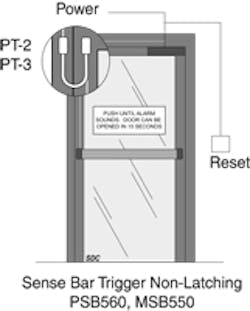Delayed egress locking arrangements basically delay egress through a subject opening for a pre-determined time. Most building codes require that delayed egress systems be connected to premises' fire alarm systems so that they unlock immediately if there is a fire alarm. Different building codes set forth additional details of how the delayed system should operate, and what accessories are mandated or permitted.
Delayed egress is very useful for a variety of purposes. The signage which is typically required to be installed on a delayed egress door is a powerful deterrent to shoplifters and would-be miscreants in loss prevention applications.
For schools and medical facilities, delayed egress systems give caregivers a head start if a disoriented patient wanders, or a child decides to explore the wild unknown.
For access control applications, which are functionally an essential element of security and life safety, delayed egress does all the above, as well as provides a viable arrangement for using card readers for both entry and egress. By being able to monitor entry as well as egress, building security personnel can know who and how many people are inside a building and their approximate locations within the site at any point in time.
This information is vital if in an emergency, a decision must be made whether to send emergency rescue into a burning structure or otherwise hostile environment. If it is established that there are people inside to save, the information provided by the system can help to determine where in the structure these individuals are most likely to be and where to deploy manpower first.
Delayed egress systems are available in several configurations to suit a wide variety of door types, occupancies, and applications.
Standalone delayed egress bars combine a positive locking latch with an electronically controlled delay. Some models use battery power, battery backup with external power supply, or external power supply only.
Besides providing the benefit of a physical lock, they are fail-secure, so loss of power to the building does not mean the door will unlock as is the case with a failsafe lock. Some of these devices do incorporate features whereby if the bar is pressed while the power is off, the device unlocks immediately.
Other delayed egress systems combine an exit device with an electromagnetic lock. The exit device provides positive locking, a switched output to the electromagnetic lock, and audible annunciation.
Another family of delayed egress devices features an electromagnetic lock with all the electronics and annunciation built-in. These devices typically are able to be used in conjunction with mechanical exit devices, REX type switch bars, or by themselves, all depending on the building code and the particular system application.
The operating sequence usually includes:
- Pressure on the door or exit device by the person attempting to egress long enough to verify that it is a legitimate attempt to use the door
- Initiation of the typical 15-second countdown to unlock accompanied by an audible alarm and possibly remote annunciation
- Unlocking the door or enabling of the exit bar so that the person can exit
- Resetting and relocking the device.
Along with the increase in the use of special locking arrangements, the number of building codes addressing these installations have also increased. As is often the case, different code writers specify different requirements. Therefore, the installer must determine the requirements the local authority having jurisdiction (LAHJ) will be enforcing, before selecting and installing delayed egress.
Nuisance Delay Requirements
Is a time period programmed into the initiating circuit that ignores short pressure on the exit bar (or door if the door is part of the initiating device)? Such events may be caused by accidentally bumping into the door, or gusts of wind, etc. The intent of a nuisance alarm is to minimize false alarms and maintain security on the door. If an exit is demanded, the individual will maintain pressure on the bar (or door), and after the nuisance time has expired, the IRREVOCABLE release countdown will initiate. At the end of the count, normally 15 seconds in total, the lock will release.
The lock will remain unlocked (without power) until manually re-locked by a reset device. The codes differ on how the reset is performed.
Currently there are five building codes in the United States and Canada. Carefully note the subtle differences between each of their requirements.
NFPA 101 SPECIAL LOCKING ARRANGEMENTS
- Nuisance Delay: Up to 3 seconds permitted
- Release Delay: 15 seconds total or with 30 seconds by approval from AHJ
- Re-locking: Manual switch, cannot be a switch located on or triggered by the movement of the door
STANDARD BUILDING CODE (SBC)
- Nuisance Delay: Not allowed
- Release Delay: 15 seconds or with 30 seconds by approval from AHJ
- Re-locking: Reset must occur only on opening, must be a switch located on or triggered by the movement of the door.
UNIFORM BUILDING CODE (UBC)
- Nuisance Delay: Required and must be set to 2 seconds
- Release Delay: 15 seconds total without options
- Re-locking: Manual switch, cannot be a switch located on or triggered by the movement of the door
BUILDING OFFICIALS CODE ADMINISTRATORS (BOCA)
- Nuisance Delay: Required and must be set at 1 second
- Release Delay: 15 seconds total or with 30 seconds by approval from AHJ
- Re-locking: Must be a switch (DPS) located on or triggered by the movement of the door. Door opening or closing triggers special timing functions. After the lock releases and the door is opened, it has preset a timer. When the door now closes, a "re-lock delay" count of 30 seconds begins. If the door is not cycled again during this 30-second period, it will lock secure. Re-locking will only occur when the door has been left undisturbed for 30 seconds after the controller has received a door-closed signal from the door position switch. The AHJ locally may extend the re-lock delay time to 45 seconds.
NATIONAL BUILDING CODE OF CANADA (NBC)
- Nuisance Delay: Up to 3 seconds permitted
- Release Delay: 15 seconds total or with 30 seconds by approval from AHJ
- Re-locking: Manual switch, cannot be a switch located on or triggered by the movement of the door
New From SDC
The SDC Mini Exit Check Delayed Egress Emlock 1581S is the new 650 lb holding force little brother to the SDC #1511. It is essentially a standalone unit requiring only a power supply and external reset device in order to operate. Of course, connection to a premises fire alarm may also be a requirement in your locality.
Holding force was an early measure of manhood among electromagnetic locks when they were still a new product category, and holding force is the easiest parameter to compare when shopping for a maglock. However, for the majority of applications, 650 lbs of hold is adequate. Typical doors have glass in them or glass sidelights or are particle board construction, and will yield to attack far less than 650 lbs.
The external reset can be a keyswitch, a keypad, or a push button. Additionally, like the SDC #1511, you can use an external trigger for the 1581S and bypass the internal one. Your application will determine if you use an internal or external trigger.
The 1581S is small so all connections are made via an eight conductor multi-conductor harness which plugs into the maglock body and is then connected to other system elements elsewhere. The 1581S can also be wired in tandem (master/slave) with a second maglock for pairs of doors.
An on-board rocker switch allows the setting of the following features:
REX TIME: This is the input which is connected to an access control or external time clock or other control. The 1581S unlocks upon REX contact closure. When the REX contacts open, the 1581S will relock in either one second or 10 seconds depending on the first rocker switch setting.
POWER-UP OPTION: When power is cut to the lock, the state in which it powers up is controlled by this rocker switch.
REMOTE TRIGGER: This allows the use of an external touchbar or other trigger for the Delayed Egress feature. This is a valuable option for the system designer.
MASTER/SLAVE: For use when a pair of locks are employed.
The 1581S also has an on-board audible alert and bi-color LED to indicate system status.
For more information, contact your local locksmith distributor or Security Door Controls, telephone 805-494-0622, web www.sdcsecurity.com.






